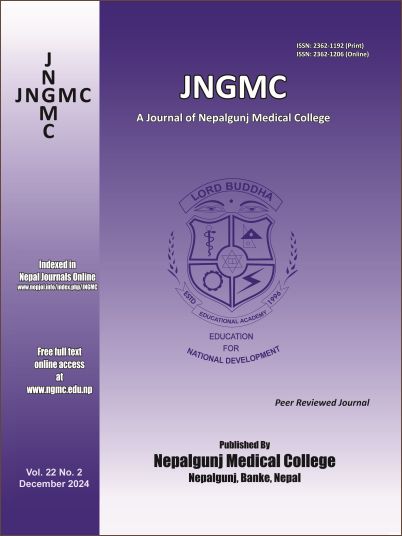Bacteriological Profile and Antibiotic Susceptibility Patterns of Chronic Non-healing Wound Infections in a Tertiary Care Hospital from North India
DOI:
https://doi.org/10.3126/jngmc.v22i2.74345Keywords:
Antibiogram, bacteriological profile, chronic wound, MDRAbstract
Introduction: Chronic wounds are becoming increasingly common as a result of an increase in the ageing population and a rising population with diabetes and obesity. These have been associated with significant financial burdens on society, directly (medi- cal and healthcare expenditures) and indirectly. Factors like infection by multi-drug resistant microorganisms, biofilm formation, inflammatory mediators, hypoxia, poor nutrition, and recurrent trauma may make the wounds chronic. Aims: To assess the bac- teriological profile of chronic wound infections and their antibiotic susceptibility pattern.
Methods: Two swabs were collected to isolate aerobic and facultative anaerobic bacteria. The isolates were then subjected to antimicrobial testing by a modified Kirby Bauer disc diffusion method, and the multi-drug resistant strain was identified to be resistant to at least three different antibiotic classes. The strain of Staphylococcus aureus was screened for methicillin resistance using a cefoxitin disc (30 μg).
Results: 100% of the samples collected from chronic wounds yielded bacterial growth. S. aureus was the most prevalent isolate at 29.2%, followed by Klebsiella pneumoniae at 22.5% and Pseudomonas aeruginosa at 17.5%. Monobacterial infection was the most frequent in 51.7% of wounds. 88.6% of the strains of S. aureus were methicillin-resistant (MRSA). MDR bacteria accounted for 95.83% of all bacterial isolates.
Conclusion: High levels of resistance to one or more antibiotic agents have been reported, and a substantial number of them exhibited multidrug resistance , indicating limited therapeutic options for managing chronic non-healing wounds. Therefore, to contain antibiotic resistance, periodic surveillance of the bacteriological profile and antibiotic sensitivity pattern in the study region is of the utmost importance in ensuring successful wound infection care with appropriate antiobiotics.
Downloads
Downloads
Published
How to Cite
Issue
Section
License
Copyright (c) 2024 Journal of Nepalgunj Medical College

This work is licensed under a Creative Commons Attribution-NonCommercial-NoDerivatives 4.0 International License.
- Attribution - You must give appropriate credit, provide a link to the license, and indicate if changes were made. You may do so in any resonable manner, but not in any way that suggests the licensor endorses you or your use.
- Non Commercial- The materials cannot be used for commercial purposes.
- No Derivatives- If the material is remixed or transformed or built upon, the modified material cannot be distributed.




